1,25-Dihydroxyvitamin D3 Suppresses Prognostic Survival Biomarkers Associated with Cell Cycle and Actin Organization in a Non-Malignant African American Prostate Cell Line
Abstract
Simple Summary
Abstract
1. Introduction
2. Materials and Methods
2.1. Ancestry Genotyping in Non-Malignant AA Cell Line RC-77N/E
2.2. Sample Preparation: Cell Culture and 1α,25(OH)2D3 Treatment
2.3. RNA Isolation from RC-77N/E Prostate Cell Line
2.4. RNA Quality Control
2.5. RNA Sequencing Library Preparation and Sequencing with Illumina HiSeq 2500
2.6. RNA-Seq Quality Control, Alignment, and Quantification
2.7. DEG Analyses
2.8. DEG Selection Algorithm
2.9. DEG Association with Survival of PCa Patients Using the Cancer Genome Atlas Prostate Adenocarcinoma (TCGA PRAD) Cohort
2.10. In Silico Bioinformatic Analysis of DEGs in 1α,25(OH)2D3-Treated RC-77N/E Cells
2.11. Validation of RNA-Seq Data through RT-qPCR
2.12. Validation of Selected DEGs in 1α,25(OH)2D3-Treated Non-Malignant EA Prostate Cell Line, RWPE1
2.13. Validation of DEGs in Prostate Clinical Cohorts
2.14. Statistical Analysis
3. Results
3.1. Ancestry Genotyping Reveals Significant West African Ancestry in RC-77N/E Cell Line
3.2. Pathway Enrichment Analysis Reveals Repression of Actin Cytoskeleton and Actin-Related Signaling Pathways Involved in Prostate Carcinogenesis
3.3. DEG Algorithm and Bioinformatic Analysis Revealed Potential Survival PCa Biomarkers That Harbor VDRE Motifs, ANLN and ECT2
3.4. ANLN and ECT2 Overexpression Is Correlated with Tumorigenesis and Gleason Score in the TCGA PRAD Cohort and an AA Clinical Cohort
3.5. ANLN and ECT2 Are Significantly Downregulated in 1α,25(OH)2D3-Treated EA and AA Non-Malignant Prostate Cell Lines
3.6. ANLN and ECT2 Are Co-Expressed and 1α,25(OH)2D3-Mediated Suppression of ANLN and ECT2 Leads to Predicted Repression of Carcinogenesis
4. Discussion
5. Conclusions
6. Limitations
Supplementary Materials
Author Contributions
Funding
Institutional Review Board Statement
Informed Consent Statement
Data Availability Statement
Acknowledgments
Conflicts of Interest
Abbreviations
| PCa | Prostate Cancer |
| AA | African American |
| EA | European American |
| RNA | Ribonucleic Acid |
| RNA-Seq | Ribonucleic Acid Sequencing |
| RT-qPCR | Real-Time Quantitative Polymerase Chain Reaction |
| PCR | Polymerase Chain Reaction |
| IPA | Ingenuity Pathway Analysis |
| FDR | False Discover Rate |
| EMT | Epithelial–Mesenchymal Transition |
| RhoA | Ras Homology Family Member A |
| DEG | Differentially Expressed Gene |
| VDRE | Vitamin D Response Element |
| TCGA | The Cancer Genome Atlas |
| PRAD | Prostate Adenocarcinoma |
| ANLN | Anillin |
| ECT2 | Epithelial Cell Transforming 2 |
| 1α,25(OH)2D3 | Calcitriol or 1,25-dihydroxyvitamin D3 |
| PSA | Prostate-Specific Antigen |
| UV | Ultraviolet |
| 25 hydroxyvitamin D3 | Calcidiol |
| c-MYC | Cellular Myelocytomatosis Oncogene |
| G0/G1 phase | Growth 0/Growth 1 phase |
| ECM | Extracellular Matrix |
| TME | Tumor Microenvironment |
| AIM | Ancestral Informative Marker |
| WA | West African |
| NA | Native American |
| WAA | West African Ancestry |
| SNP | Single Nucleotide Polymorphism |
| DNA | Deoxyribonucleic Acid |
| CHIP | Chromatin Immunoprecipitation |
| MALDI-TOF | Matrix-Assisted Laser Desorption/Ionization Time of Flight |
| ATCC | American Type Culture Collection |
| OD | Optical Density |
| PCA | Principal Component Analysis |
| GO | Gene Ontology |
| cDNA | Complimentary DNA |
| GAPDH | Glyceraldehyde 3-Phosphate Dehydrogenase |
| GEO | Gene Expression Omnibus |
| JUN | Jun Proto-oncogene AP-1 transcription factor subunit |
| JUNB | JunB Proto-oncogene AP-1 transcription factor subunit |
| EGFR | Epithelial Growth Factor Receptor) |
| EGR | Early Growth Response |
| FOXM1 | Forkhead box protein M1 |
| IL17A | Interleukin 17A |
| IL1A | Interleukin1A |
| IL1B | Interleukin 1B |
| TNF | Tumor Necrosis Factor |
| ARP-WASP | Actin-related Protein Wiskott–Aldrich Syndrome Protein |
| CKAP4 | Cytoskeleton-Associated Protein 4 |
| DIAPH3 | Diaphanous-Related Formin 3 |
| FGF5 | Fibroblast Growth Factor 5 |
| ITGB6 | Integrin Subunit Beta 6 |
| PDGFC | Platelet-Derived Growth Factor |
| TGFBR2 | Transforming Growth Factor Beta Receptor 2 |
| JAG1 | Jagged Canonical Notch Ligand 1 |
| NOTCH2 | Neurogenic Locus Notch Homolog Protein 2 |
| PDZD2 | PDZ Domain Containing 2 |
| MYO1E | Myosin-1E |
| WDR36 | WD Repeat Domain 36 |
| STAG3 | Stromal Antigen 3 |
| NF-kB | Nuclear Factor-Kappa B |
| IGFBP-3 | Insulin-like Growth Factor Binding Protein 3 |
| FAS | Fas Cell Surface Death Receptor |
| Wee1 | Wee1 G2 Checkpoint Kinase |
| G1/S phase | Growth 1/Synthesis Phase |
| G2/M phase | Growth 2/Mitosis Phase |
| CIN | Chromosome Instability |
| JAG1 | Jagged 1 |
| VDR | Vitamin D Receptor |
References
- Siegel, R.L.; Miller, K.D.; Wagle, N.S.; Jemal, A. Cancer statistics, 2023. CA Cancer J. Clin. 2023, 73, 17–48. [Google Scholar] [CrossRef]
- Grizzle, W.E.; Kittles, R.A.; Rais-Bahrami, S.; Shah, E.; Adams, G.W.; DeGuenther, M.S.; Kolettis, P.N.; Nix, J.W.; Bryant, J.E.; Chinsky, R.; et al. Self-Identified African Americans and prostate cancer risk: West African genetic ancestry is associated with prostate cancer diagnosis and with higher Gleason sum on biopsy. Cancer Med. 2019, 8, 6915–6922. [Google Scholar] [CrossRef]
- Johnson, J.R.; Woods-Burnham, L.; Hooker, S.E., Jr.; Batai, K.; Kittles, R.A. Genetic Contributions to Prostate Cancer Disparities in Men of West African Descent. Front. Oncol. 2021, 11, 770500. [Google Scholar] [CrossRef]
- Woods-Burnham, L.; Johnson, J.R.; Hooker, S.E., Jr.; Bedell, F.W.; Dorff, T.B.; Kittles, R.A. The Role of Diverse Populations in US Clinical Trials. Med 2021, 2, 21–24. [Google Scholar] [CrossRef]
- Hansen, M.; Hamieh, N.M.; Markt, S.C.; Vaselkiv, J.B.; Pernar, C.H.; Gonzalez-Feliciano, A.G.; Peisch, S.; Chowdhury-Paulino, I.M.; Rencsok, E.M.; Rebbeck, T.R.; et al. Racial Disparities in Prostate Cancer: Evaluation of Diet, Lifestyle, Family History, and Screening Patterns. Cancer Epidemiol. Biomark. Prev. 2022, 31, 982–990. [Google Scholar] [CrossRef]
- Johnson, J.R.; Mavingire, N.; Woods-Burnham, L.; Walker, M.; Lewis, D.; Hooker, S.E.; Galloway, D.; Rivers, B.; Kittles, R.A. The complex interplay of modifiable risk factors affecting prostate cancer disparities in African American men. Nat. Rev. Urol. 2024. [Google Scholar] [CrossRef]
- Bock, C.H.; Schwartz, A.G.; Ruterbusch, J.J.; Levin, A.M.; Neslund-Dudas, C.; Land, S.J.; Wenzlaff, A.S.; Reich, D.; McKeigue, P.; Chen, W.; et al. Results From a Prostate Cancer Admixture Mapping Study in African-American Men. Hum. Genet. 2009, 126, 637–642. [Google Scholar] [CrossRef]
- Zeigler-Johnson, C.M.; Spangler, E.; Jalloh, M.; Gueye, S.M.; Rennert, H.; Rebbeck, T.R. Genetic Susceptibility to Prostate Cancer in Men of African Descent: Implications for Global Disparities in Incidence and Outcomes. Can. J. Urol. 2008, 15, 3872–3882. [Google Scholar]
- Smith, Z.L.; Eggener, S.E.; Murphy, A.B. African-American Prostate Cancer Disparities. Curr. Urol. Rep. 2017, 18, 81. [Google Scholar] [CrossRef] [PubMed]
- Siddappa, M.; Hussain, S.; Wani, S.A.; White, J.; Tang, H.; Gray, J.S.; Jafari, H.; Wu, H.C.; Long, M.D.; Elhussin, I.; et al. African American Prostate Cancer Displays Quantitatively Distinct Vitamin D Receptor Cistrome-transcriptome Relationships Regulated by BAZ1A. Cancer Res. Commun. 2023, 3, 621–639. [Google Scholar] [CrossRef] [PubMed]
- Nelson, S.M.; Batai, K.; Ahaghotu, C.; Agurs-Collins, T.; Kittles, R.A. Association between Serum 25-Hydroxy-Vitamin D and Aggressive Prostate Cancer in African American Men. Nutrients 2016, 9, 12. [Google Scholar] [CrossRef]
- Schwartz, G.G. Vitamin D and the epidemiology of prostate cancer. Semin. Dial. 2005, 18, 276–289. [Google Scholar] [CrossRef]
- Murphy, A.B.; Kelley, B.; Nyame, Y.A.; Martin, I.K.; Smith, D.J.; Castaneda, L.; Zagaja, G.J.; Hollowell, C.M.; Kittles, R.A. Predictors of serum vitamin D levels in African American and European American men in Chicago. Am. J. Men’s Health 2012, 6, 420–426. [Google Scholar] [CrossRef]
- Murphy, A.B.; Nyame, Y.; Martin, I.K.; Catalona, W.J.; Hollowell, C.M.; Nadler, R.B.; Kozlowski, J.M.; Perry, K.T.; Kajdacsy-Balla, A.; Kittles, R. Vitamin D deficiency predicts prostate biopsy outcomes. Clin. Cancer Res. 2014, 20, 2289–2299. [Google Scholar] [CrossRef]
- Haddad, S.A.; Ruiz-Narváez, E.A.; Cozier, Y.C.; Gerlovin, H.; Rosenberg, L.; Palmer, J.R. Association of Degree of European Genetic Ancestry With Serum Vitamin D Levels in African Americans. Am. J. Epidemiol. 2018, 187, 1420–1423. [Google Scholar] [CrossRef]
- Bassuk, S.S.; Chandler, P.D.; Buring, J.E.; Manson, J.E. The VITamin D and OmegA-3 TriaL (VITAL): Do Results Differ by Sex or Race/Ethnicity? Am. J. Lifestyle Med. 2021, 15, 372–391. [Google Scholar] [CrossRef]
- Christakos, S.; Dhawan, P.; Verstuyf, A.; Verlinden, L.; Carmeliet, G. Vitamin D: Metabolism, Molecular Mechanism of Action, and Pleiotropic Effects. Physiol. Rev. 2016, 96, 365–408. [Google Scholar] [CrossRef]
- Muindi, J.R.; Yu, W.-D.; Ma, Y.; Engler, K.L.; Kong, R.-X.; Trump, D.L.; Johnson, C.S. CYP24A1 Inhibition Enhances the Antitumor Activity of Calcitriol. Endocrinology 2010, 151, 4301–4312. [Google Scholar] [CrossRef]
- Trump, D.L.; Hershberger, P.A.; Bernardi, R.J.; Ahmed, S.; Muindi, J.; Fakih, M.; Yu, W.D.; Johnson, C.S. Anti-tumor activity of calcitriol: Pre-clinical and clinical studies. J. Steroid Biochem. Mol. Biol. 2004, 89–90, 519–526. [Google Scholar] [CrossRef]
- Sun, X.; Zemel, M.B. Role of uncoupling protein 2 (UCP2) expression and 1alpha, 25-dihydroxyvitamin D3 in modulating adipocyte apoptosis. FASEB J. 2004, 18, 1430–1432. [Google Scholar] [CrossRef]
- Peehl, D.M.; Feldman, D. The role of Vitamin D and retinoids in controlling prostate cancer progression. Endocr. Relat. Cancer 2003, 10, 131–140. [Google Scholar] [CrossRef] [PubMed]
- Zeng, N.; Salker, M.S.; Zhang, S.; Singh, Y.; Shi, B.; Stournaras, C.; Lang, F. 1α,25(OH)2D3 induces actin depolymerization in endometrial carcinoma cells by targeting RAC1 and PAK1. Cell. Physiol. Biochem. 2016, 40, 1455–1464. [Google Scholar] [CrossRef] [PubMed]
- Moreno, J.; Krishnan, A.V.; Swami, S.; Nonn, L.; Peehl, D.M.; Feldman, D. Regulation of prostaglandin metabolism by calcitriol attenuates growth stimulation in prostate cancer cells. Cancer Res. 2005, 65, 7917–7925. [Google Scholar] [CrossRef] [PubMed]
- Trump, D.L.; Aragon-Ching, J.B. Vitamin D in prostate cancer. Asian J. Androl. 2018, 20, 244–252. [Google Scholar] [CrossRef] [PubMed]
- Kosoy, R.; Nassir, R.; Tian, C.; White, P.A.; Butler, L.M.; Silva, G.; Kittles, R.; Alarcon-Riquelme, M.E.; Gregersen, P.K.; Belmont, J.W.; et al. Ancestry informative marker sets for determining continental origin and admixture proportions in common populations in America. Hum. Mutat. 2009, 30, 69–78. [Google Scholar] [CrossRef]
- Nassir, R.; Kosoy, R.; Tian, C.; White, P.A.; Butler, L.M.; Silva, G.; Kittles, R.; Alarcon-Riquelme, M.E.; Gregersen, P.K.; Belmont, J.W.; et al. An ancestry informative marker set for determining continental origin: Validation and extension using human genome diversity panels. BMC Genet. 2009, 10, 39. [Google Scholar] [CrossRef]
- Torres, J.B.; Stone, A.C.; Kittles, R. An anthropological genetic perspective on Creolization in the Anglophone Caribbean. Am. J. Phys. Anthropol. 2013, 151, 135–143. [Google Scholar] [CrossRef] [PubMed]
- Falush, D.; Stephens, M.; Pritchard, J.K. Inference of population structure using multilocus genotype data: Linked loci and correlated allele frequencies. Genetics 2003, 164, 1567–1587. [Google Scholar] [CrossRef]
- Andrews, S. FastQC: A Quality Control Tool for Highthroughput Sequencing Data; Babraham Institute: Babraham, UK, 2020. [Google Scholar]
- Bolger, A.M.; Lohse, M.; Usadel, B. Trimmomatic: A flexible trimmer for Illumina sequence data. Bioinformatics 2014, 30, 2114–2120. [Google Scholar] [CrossRef]
- Pertea, M.; Kim, D.; Pertea, G.M.; Leek, J.T.; Salzberg, S.L. Transcript-level expression analysis of RNA-seq experiments with HISAT, StringTie and Ballgown. Nat. Protoc. 2016, 11, 1650–1667. [Google Scholar] [CrossRef]
- Love, M.I.; Huber, W.; Anders, S. Moderated estimation of fold change and dispersion for RNA-seq data with DESeq2. Genome Biol. 2014, 15, 550. [Google Scholar] [CrossRef] [PubMed]
- Therneau, T.M.; Grambsch, P.M. Modeling Survival Data: Extending the Cox Model. In Statistics for Biology and Health; Springer: New York, NY, USA, 2000. [Google Scholar]
- Krämer, A.; Green, J.; Pollard, J., Jr.; Tugendreich, S. Causal analysis approaches in Ingenuity Pathway Analysis. Bioinformatics 2014, 30, 523–530. [Google Scholar] [CrossRef] [PubMed]
- Huang, D.W.; Sherman, B.T.; Lempicki, R.A. Systematic and integrative analysis of large gene lists using DAVID bioinformatics resources. Nat. Protoc. 2009, 4, 44–57. [Google Scholar] [CrossRef] [PubMed]
- Huang, D.W.; Sherman, B.T.; Lempicki, R.A. Bioinformatics enrichment tools: Paths toward the comprehensive functional analysis of large gene lists. Nucleic Acids Res. 2009, 37, 1–13. [Google Scholar] [CrossRef] [PubMed]
- Szklarczyk, D.; Kirsch, R.; Koutrouli, M.; Nastou, K.; Mehryary, F.; Hachilif, R.; Gable, A.L.; Fang, T.; Doncheva, N.T.; Pyysalo, S.; et al. The STRING database in 2023: Protein-protein association networks and functional enrichment analyses for any sequenced genome of interest. Nucleic Acids Res. 2023, 51, D638–D646. [Google Scholar] [CrossRef] [PubMed]
- Theodore, S.; Sharp, S.; Zhou, J.; Turner, T.; Li, H.; Miki, J.; Ji, Y.; Patel, V.; Yates, C.; Rhim, J.S. Establishment and characterization of a pair of non-malignant and malignant tumor derived cell lines from an African American prostate cancer patient. Int. J. Oncol. 2010, 37, 1477–1482. [Google Scholar] [PubMed]
- Holick, C.N.; Stanford, J.L.; Kwon, E.M.; Ostrander, E.A.; Nejentsev, S.; Peters, U. Comprehensive association analysis of the vitamin D pathway genes, VDR, CYP27B1, and CYP24A1, in prostate cancer. Cancer Epidemiol. Biomark. Prev. 2007, 16, 1990–1999. [Google Scholar] [CrossRef] [PubMed]
- Wang, W.L.W.; Chatterjee, N.; Chittur, S.V.; Welsh, J.; Tenniswood, M.P. Effects of 1 alpha, 25 dihydroxyvitamin D3 and testosterone on miRNA snd mRNA expression in LNCaP cells. Mol. Cancer 2011, 10, 58. [Google Scholar] [CrossRef] [PubMed]
- Wang, T.-T.; Tavera-Mendoza, L.E.; Laperriere, D.; Libby, E.; Burton MacLeod, N.; Nagai, Y.; Bourdeau, V.; Konstorum, A.; Lallemant, B.; Zhang, R.; et al. Large-Scale in Silico and Microarray-Based Identification of Direct 1,25-Dihydroxyvitamin D3 Target Genes. Mol. Endocrinol. 2005, 19, 2685–2695. [Google Scholar] [CrossRef] [PubMed]
- Xu, D.; Wang, Y.; Wu, J.; Zhang, Z.; Chen, J.; Xie, M.; Tang, R.; Chen, C.; Chen, L.; Lin, S.; et al. ECT2 overexpression promotes the polarization of tumor associated macrophages in hepatocellular carcinoma via the ECT2/PLK/PTEN pathway. Cell Death Dis. 2021, 12, 162. [Google Scholar] [CrossRef]
- Zhou, S.; Wang, P.; Su, X.; Chen, J.; Chen, H.; Yang, H.; Fang, A.; Xie, L.; Yao, Y.; Yang, J. High ECT2 expression is an independent prognostic factor for poor overall survival and recurrence-free survival in non-small cell lung adenocarcinoma. PLoS ONE 2017, 12, e0187356. [Google Scholar] [CrossRef]
- Hall, P.A.; Todd, C.B.; Hyland, P.L.; McDade, S.S.; Grabsch, H.; Dattani, M.; Hillan, K.J.; Russell, S.H. The septin-binding protein anillin is overexpressed in diverse human tumors. Clin. Cancer Res. 2005, 11, 6780–6786. [Google Scholar] [CrossRef]
- Frenette, P.; Haines, E.; Loloyan, M.; Kinal, M.; Pakarian, P.; Piekny, A. An Anillin-ECT2 complex stabalizes central spindle microtubules at the cortex during cytokinesis. PLoS ONE 2012, 7, e34888. [Google Scholar] [CrossRef]
- Kovalenko, P.L.; Zhang, Z.; Cui, M.; Clinton, S.K.; Fleet, J.C. 1,25 dihydroxyvitamin D-mediated orchestration of anticancer, transcript-level effects in the immortalized, non-transformed prostate epithelial cell line, RWPE1. BMC Genom. 2010, 11, 26. [Google Scholar] [CrossRef]
- Donkena, K.V.; Young, C.Y. Vitamin d, sunlight and prostate cancer risk. Adv. Prev. Med. 2011, 2011, 281863. [Google Scholar] [CrossRef]
- Kramer, A.; Richards, D.R.; Bowlby, J.O.; Felciano, R.M. Functional modularity in a large-scale mammalian molecular interaction network. In Proceedings of the 2005 IEEE Computational Systems Bioinformatics Conference—Workshops (CSBW’05), Stanford, CA, USA, 8–12 August 2005; pp. 161–163. [Google Scholar]
- Carlberg, C.; Muñoz, A. An update on vitamin D signaling and cancer. Semin. Cancer Biol. 2022, 79, 217–230. [Google Scholar] [CrossRef]
- Risbridger, G.P.; Toivanen, R.; Taylor, R.A. Preclinical Models of Prostate Cancer: Pateint-Derived Xenografts, Organoids and Other Explant Models. Cold Spring Harb. Perspect. Med. 2018, 8, a030536. [Google Scholar] [CrossRef]
- Thomsen, M.K.; Busk, M. Pre-Clinical Models to Study Human Prostate Cancer. Cancers 2023, 15, 4212. [Google Scholar] [CrossRef]
- Tuan, N.M.; Lee, C.H. Role of Anillin in Tumour: From a prognostic Biomarker to a Novel Target. Cancers 2020, 12, 1600. [Google Scholar] [CrossRef] [PubMed]
- McKenzie, C.; D’Avino, P.P. Investigation Cytokinesis failure as a strategy in cancer therapy. Oncotarget 2016, 7, 87323. [Google Scholar] [CrossRef] [PubMed]
- Schulz, W.A.; Ingenwerth, M.; Djuidje, C.E.; Hader, C.; Rahnenführer, J.; Engers, R. Changes in cortical cytoskeletal and extracellular matrix gene expression in prostate cancer are related to oncogenic ERG deregulation. BMC Cancer 2010, 10, 505. [Google Scholar] [CrossRef] [PubMed]
- Haffner, M.C.; Esopi, D.M.; Chaux, A.; Gürel, M.; Ghosh, S.; Vaghasia, A.M.; Tsai, H.; Kim, K.; Castagna, N.; Lam, H.; et al. AIM1 is an actin-binding protein that suppresses cell migration and micrometastatic dissemination. Nat. Commun. 2017, 8, 142. [Google Scholar] [CrossRef] [PubMed]
- Virtanen, S.S.; Ishizu, T.; Sandholm, J.A.; Löyttyniemi, E.; Väänänen, H.K.; Tuomela, J.M.; Härkönen, P.L. Alendronate-induced disruption of actin cytoskeleton and inhibition of migration/invasion are associated with cofilin downregulation in PC-3 prostate cancer cells. Oncotarget 2018, 9, 32593–32608. [Google Scholar] [CrossRef] [PubMed]
- Brackman, D.; Trydal, T.; Lillehaug, J.R.; Aarskog, D. Reorganization of the cytoskeleton and morphological changes induced by 1,25-dihydroxyvitamin D3 in C3H/10T1/2 mouse embryo fibroblasts: Relation to inhibition of proliferation. Exp. Cell Res. 1992, 201, 485–493. [Google Scholar] [CrossRef] [PubMed]
- Wang, B.D.; Yang, Q.; Ceniccola, K.; Bianco, F.; Andrawis, R.; Jarrett, T.; Frazier, H.; Patierno, S.R.; Lee, N.H. Androgen receptor-target genes in african american prostate cancer disparities. Prostate Cancer 2013, 2013, 763569. [Google Scholar] [CrossRef] [PubMed]
- Zhang, L.; Wei, Y.; He, Y.; Wang, X.; Huang, Z.; Sun, L.; Chen, J.; Zhu, Q.; Zhou, X. Clinical implication and immunological landscape analyses of ANLN in pan-cancer: A new target for cancer research. Cancer Med. 2023, 12, 4907–4920. [Google Scholar] [CrossRef] [PubMed]
- Zhang, X.; Li, L.; Huang, S.; Liao, W.; Li, J.; Huang, Z.; Huang, Y.; Lian, Y. Comprehensive Analysis of ANLN in Human Tumors: A Prognostic Biomarker Associated with Cancer Immunity. Oxidative Med. Cell. Longev. 2022, 2022, 5322929. [Google Scholar] [CrossRef] [PubMed]
- Shi, Y.; Ma, X.; Wang, M.; Lan, S.; Jian, H.; Wang, Y.; Wei, Q.; Zhong, F. Comprehensive analyses reveal the carcinogenic and immunological roles of ANLN in human cancers. Cancer Cell Int. 2022, 22, 188. [Google Scholar] [CrossRef]
- Guo, Z.; Chen, X.; Du, T.; Zhu, D.; Lai, Y.; Dong, W.; Wu, W.; Lin, C.; Liu, L.; Huang, H. Elevated levels of epithelial cell transforming 2 predicts poor prognosis for prostate cancer. Med. Oncol. 2017, 34, 13. [Google Scholar] [CrossRef] [PubMed]
- Ulke, H.M.; Mutze, K.; Lehmann, M.; Wagner, D.E.; Heinzelmann, K.; Günther, A.; Eickelberg, O.; Königshoff, M. The Oncogene ECT2 Contributes to a Hyperplastic, Proliferative Lung Epithelial Cell Phenotype in Idiopathic Pulmonary Fibrosis. Am. J. Respir. Cell Mol. Biol. 2019, 61, 713–726. [Google Scholar] [CrossRef]
- Tamura, K.; Furihata, M.; Tsunoda, T.; Ashida, S.; Takata, R.; Obara, W.; Yoshioka, H.; Daigo, Y.; Nasu, Y.; Kumon, H.; et al. Molecular features of Hormone-refractory prostate cancer cells by genome-wide gene expression profiles. Cancer Res. 2007, 67, 5117–5125. [Google Scholar] [CrossRef] [PubMed]
- Zhang, S.; Nguyen, L.H.; Zhou, K.; Tu, H.-C.; Sehgal, A.; Nassour, I.; Li, L.; Gopal, P.; Goodman, J.; Singal, A.G.; et al. Knockdown of Anillin Actin Binding Protein Blocks Cytokinesis in Hepatocytes and Reduces Liver Tumor Development in Mice Without Affecting Regeneration. Gastroenterology 2018, 154, 1421–1434. [Google Scholar] [CrossRef] [PubMed]
- Liu, J.; Wang, S.; Zhang, C.; Wei, Z.; Han, D.; Song, Y.; Song, X.; Chao, F.; Wu, Z.; Xu, G.; et al. Anillin contributes to prostate cancer progression through the regulation of IGF2BP1 to promote c-Myc and MAPK signaling. Am. J. Cancer Res. 2024, 14, 490–506. [Google Scholar] [CrossRef] [PubMed]

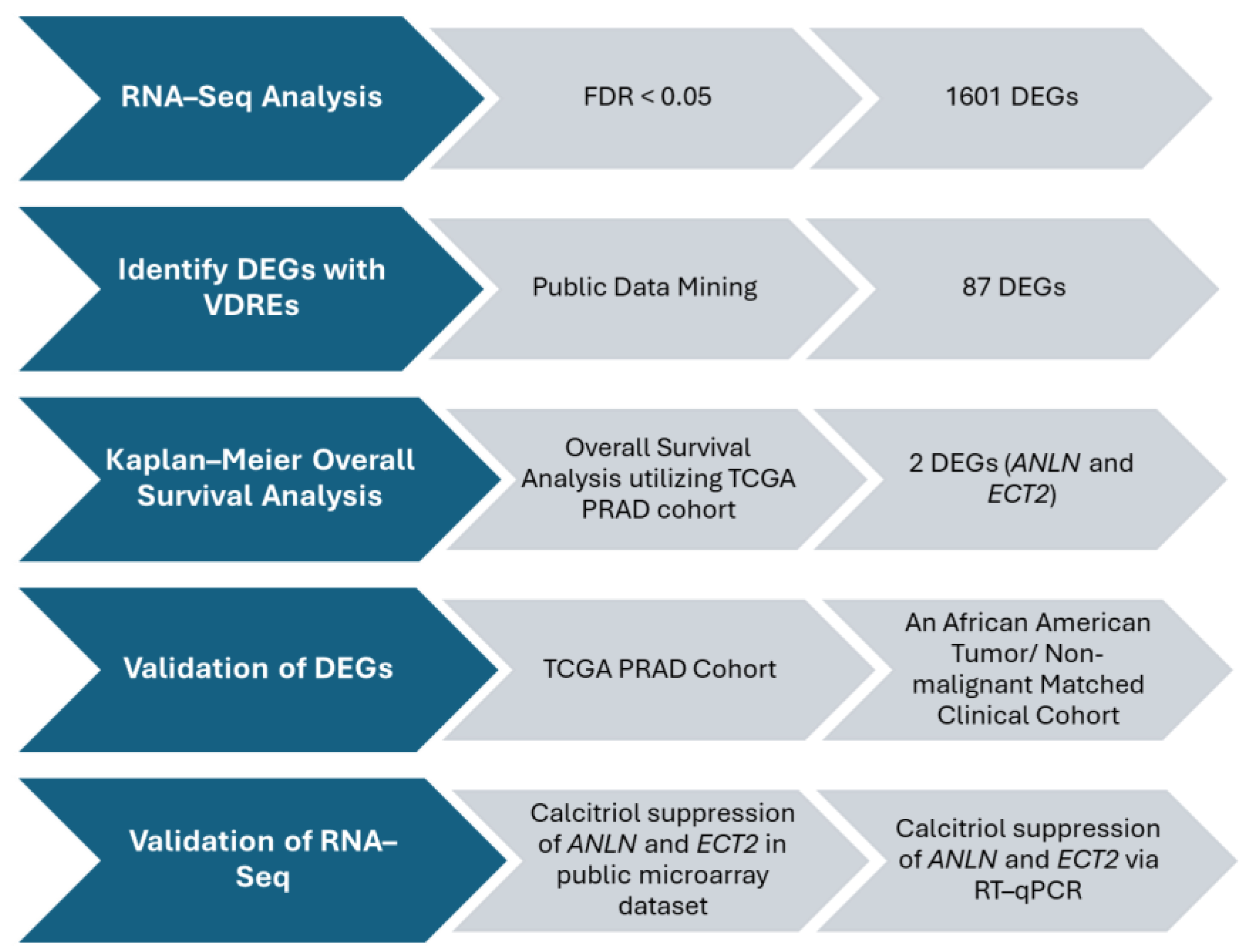

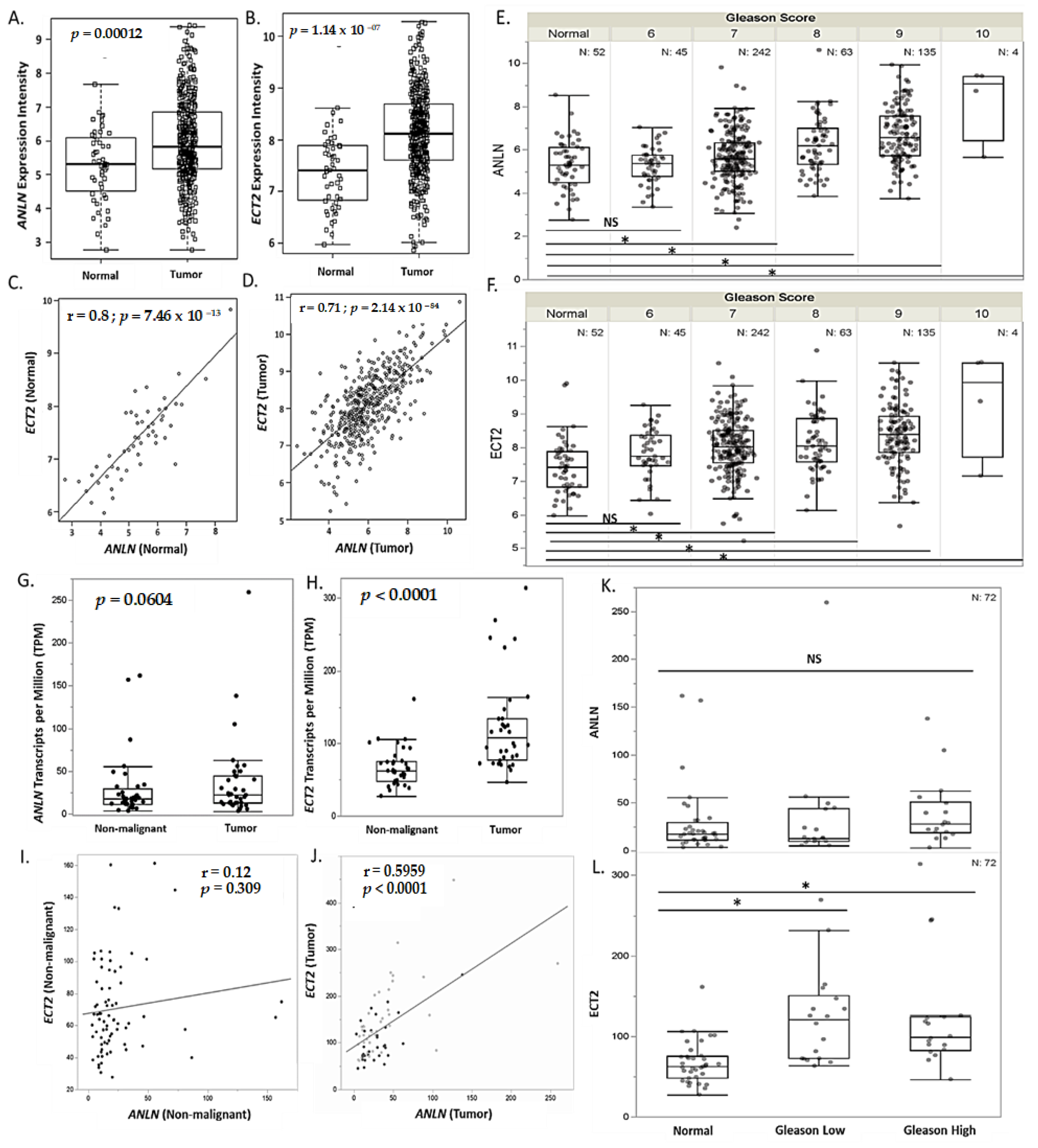
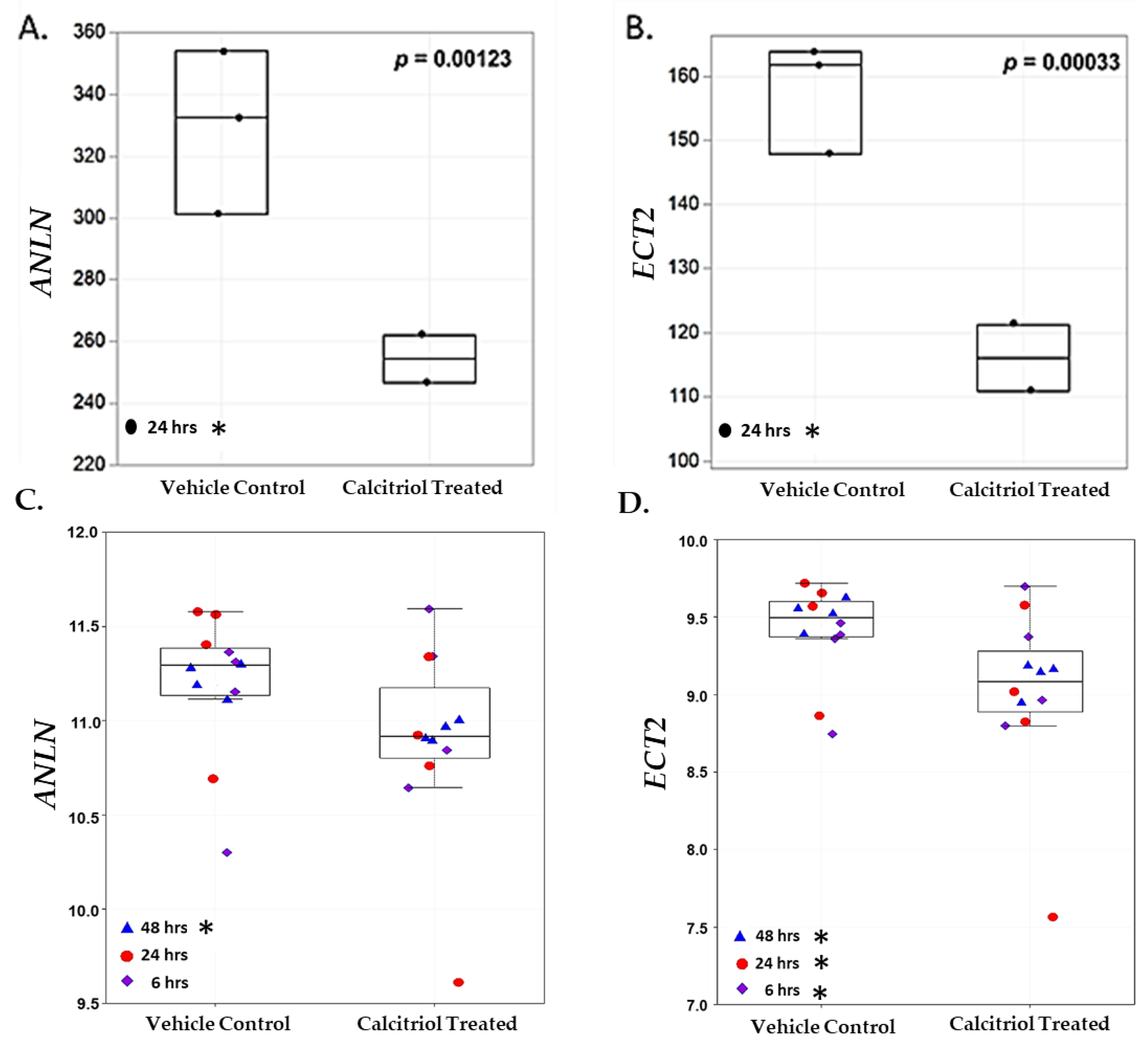
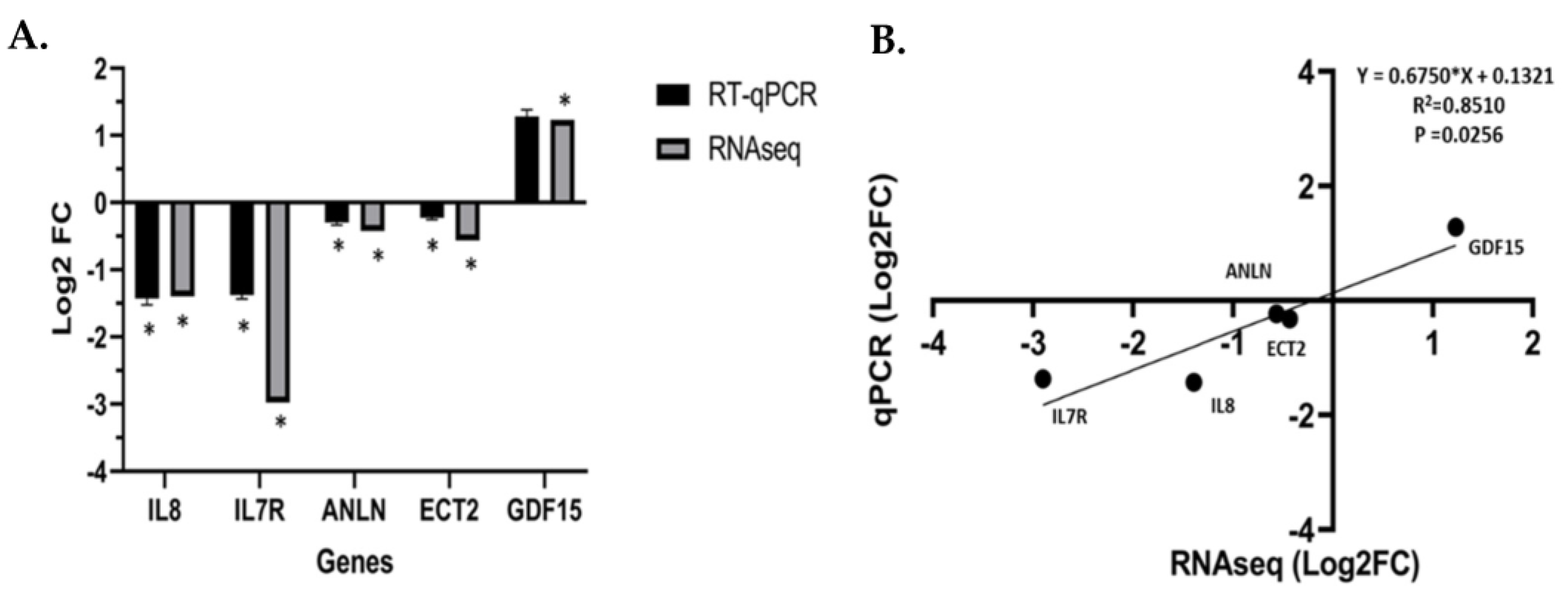
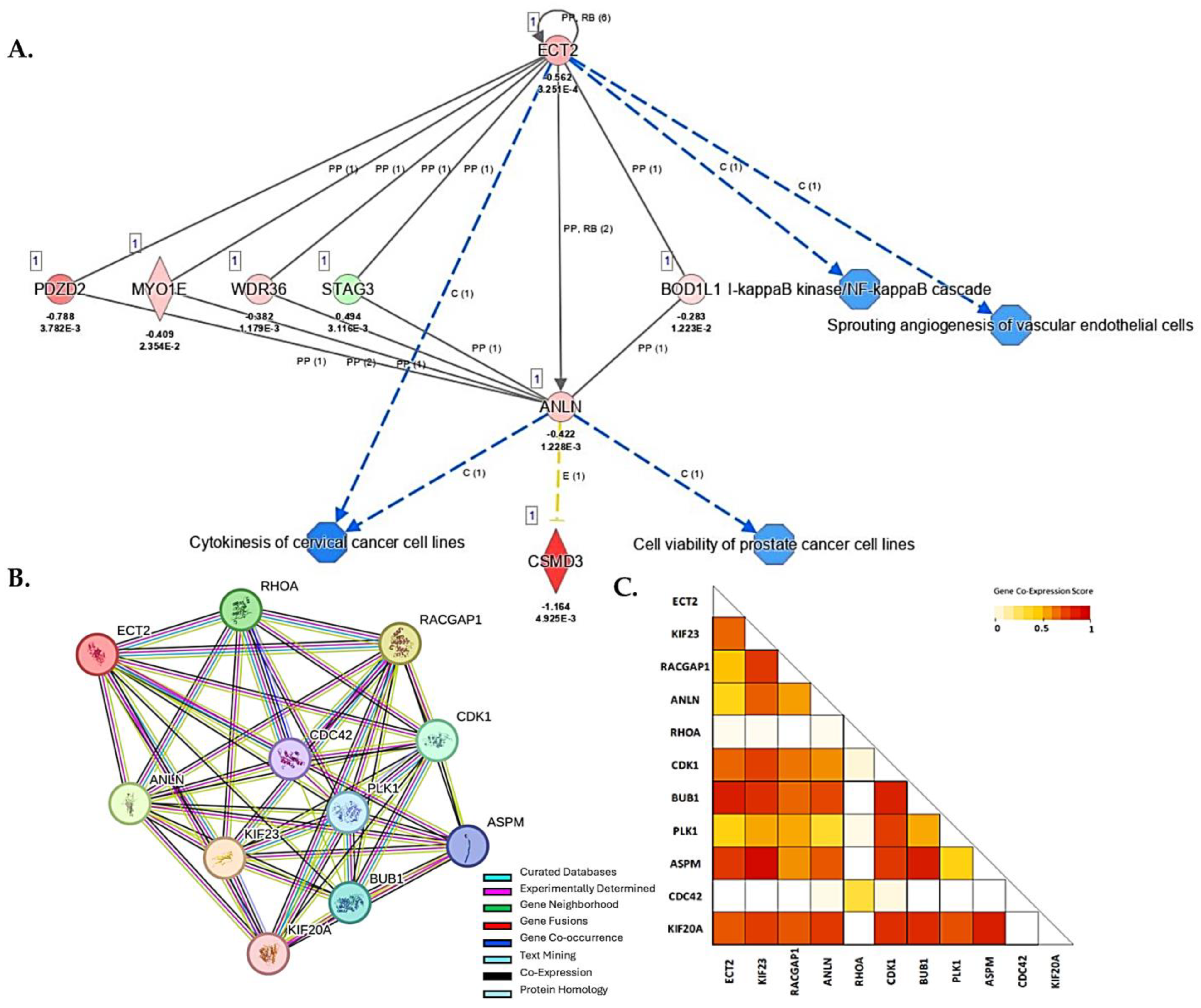
Disclaimer/Publisher’s Note: The statements, opinions and data contained in all publications are solely those of the individual author(s) and contributor(s) and not of MDPI and/or the editor(s). MDPI and/or the editor(s) disclaim responsibility for any injury to people or property resulting from any ideas, methods, instructions or products referred to in the content. |
© 2024 by the authors. Licensee MDPI, Basel, Switzerland. This article is an open access article distributed under the terms and conditions of the Creative Commons Attribution (CC BY) license (https://creativecommons.org/licenses/by/4.0/).
Share and Cite
Johnson, J.R.; Martini, R.N.; Yuan, Y.-C.; Woods-Burnham, L.; Walker, M.; Ortiz-Hernandez, G.L.; Kobeissy, F.; Galloway, D.; Gaddy, A.; Oguejiofor, C.; et al. 1,25-Dihydroxyvitamin D3 Suppresses Prognostic Survival Biomarkers Associated with Cell Cycle and Actin Organization in a Non-Malignant African American Prostate Cell Line. Biology 2024, 13, 346. https://doi.org/10.3390/biology13050346
Johnson JR, Martini RN, Yuan Y-C, Woods-Burnham L, Walker M, Ortiz-Hernandez GL, Kobeissy F, Galloway D, Gaddy A, Oguejiofor C, et al. 1,25-Dihydroxyvitamin D3 Suppresses Prognostic Survival Biomarkers Associated with Cell Cycle and Actin Organization in a Non-Malignant African American Prostate Cell Line. Biology. 2024; 13(5):346. https://doi.org/10.3390/biology13050346
Chicago/Turabian StyleJohnson, Jabril R., Rachel N. Martini, Yate-Ching Yuan, Leanne Woods-Burnham, Mya Walker, Greisha L. Ortiz-Hernandez, Firas Kobeissy, Dorothy Galloway, Amani Gaddy, Chidinma Oguejiofor, and et al. 2024. "1,25-Dihydroxyvitamin D3 Suppresses Prognostic Survival Biomarkers Associated with Cell Cycle and Actin Organization in a Non-Malignant African American Prostate Cell Line" Biology 13, no. 5: 346. https://doi.org/10.3390/biology13050346
APA StyleJohnson, J. R., Martini, R. N., Yuan, Y.-C., Woods-Burnham, L., Walker, M., Ortiz-Hernandez, G. L., Kobeissy, F., Galloway, D., Gaddy, A., Oguejiofor, C., Allen, B., Lewis, D., Davis, M. B., Kimbro, K. S., Yates, C. C., Murphy, A. B., & Kittles, R. A. (2024). 1,25-Dihydroxyvitamin D3 Suppresses Prognostic Survival Biomarkers Associated with Cell Cycle and Actin Organization in a Non-Malignant African American Prostate Cell Line. Biology, 13(5), 346. https://doi.org/10.3390/biology13050346






